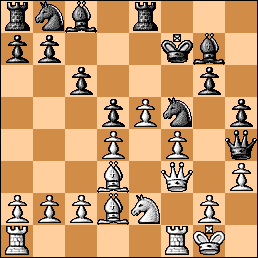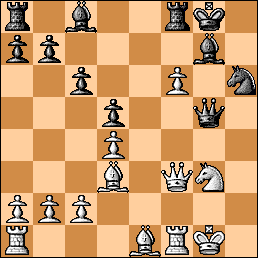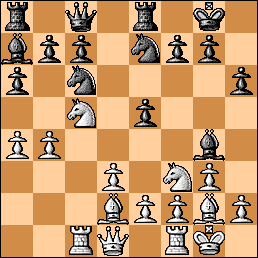Tulsa!
The 2008 Qualifier was held in a restaurant-less roadside motel. Here’s a picture of a sushi train in the eponymously named nearby eaterie, Sushi Train. See this post for some chess theory from the event.

The Sushi Train Comin’ to Getcha
Sushi Train was a hoot. The train circles the patrons continuously and it’s just one big fish pig-out. Ilya Gurevich and I used to go to a place in Japantown, San Francisco, with a similar (but smaller and less fancy) train. Sushi Train’s train was gaily decorated and had a little signal and warning bar that raised and lowered. It even had a locomotive with a little guy in there and a train-repair car! Of course, food critics might say “Fish in Tulsa??”
To get to Sushi Train, it was necessary to cross several major intersections. Chess players were often seen clutching their equipment bags and running for their life after “overlooking” some people had a green left turn arrow. Other attractions in the area included KMart, Chili’s, a boobie barn named “Tabu” and a rock music nightclub in the playing site. The playing site, some sort of Best Western, had no restaurant, opting for a rather bizarre “club only” option. Here’s a picture of the boobie barn which was conveniently located near a diamond wholesaler that was going out of business. Thus, a possible course of action is to pick up a 70% discounted diamond then head over to Tabu with some nice tips for the dancers in the form of loose stones.

The Boobie Barn “Tabu” – it’s the hut under the Forced Liquidation Sign
Chess?
My own games were a dismal collection. After the “high” of Foxwoods, I had a “bummer”. Too many games packed into each day, an endless assortment of bad take out food (Fedorowicz looked at my gruel-like soup that I was slurping out of a styrofoam container and said “Looks Good”) and a nerve-wracking time control (G/90 + 30 sec delay) led to numerous shall we say sub-optimal resuls. For example, in Round 1 I lost to Coleman. FM Teddy Coleman? No, an expert, Maxx Coleman. My ingenious opening combination led to the immediate loss of a piece which he of course overlooked. The blunder fest continued with me walking into a knight fork. Bravo! After a few wins, I pulled up lame again with a loss to a candidate master, overlooking a one-mover in a slightly superior ending with no losing chances. Bravo!
There were a few chessic things worth mentioning.
Hanken Parts with the Dude
Round 1 saw a wipeout – GM Alex Yermolinsky dropped the People’s Elbow on Jerry Hanken when Jerry ignored every basic opening principle. You can’t do that against GMs. Hanken “parted with the Dude” (his own King) in short order on the white side of a Catalan, which is rather difficult to do.
Jerry Hanken – GM Alex Yermolinsky Round 1. A Catalan Not to Be Emulated.
1.c4 e6 2.g3 d5 3.Bg2 Nf6 4.Nf3 dxc4 5.Qa4 Nbd7 6.O-O a6 7.Qxc4 b5 8.Qc2 Bb7 9.d4 c5 10.Bg5 I believe this position was discussed in GM Beliavsky’s autobiography, Uncompromising Chess. But not the way this game develops.
10…Rc8 11.Qd1 h6 12.Bc1?? Ugh. Never anti-develop versus a GM.
12…Qb6 13.Nc3 cxd4 14.Qxd4 Bc5 15.Qh4 Ke7 16.g4 Ugh. 16…g5 17.Qh3 Qc7 18.Ne1 Ne5 19.Bf3 Rcg8 20.Nd3 Nxf3 21.exf3 Bd6 22.Ne4 Nxe4 23.fxe4 Bxe4 24.Ne1 h5 25.f3 Grotesque. A computer would have resigned. 25…hxg4 26.Bxg5 Rxg5 27.Qxh8 gxf3 0-1 I haven’t seen such senseless butchery since watching the CNN evening news.
Squelching the Moptop
Then in Round 2 we had a very instructional sequence. IM Josh Friedel in a very Russian-styled (think Lein of the old days) game neutralized and then tortured young Daniel Naroditsky when Daniel played a very slow King’s Indian “Attack” as white and then horribly weakened his own f4 square with an instructive positional mistake. That is a very youthful mistake; once a youth makes it, he or she remembers and it tends not to happen again! Trips to Russia will teach one how to play in that grand CCCP-torture mode. Here is the game:
FM Daniel Naroditsky – IM Josh Friedel Round 2 King’s Indian “Attack”
1.Nf3 d5 2.g3 c6 Many Russians play 2…Bg4 right away here.
3.Bg2 Bg4 4.O-O Nd7 5.d3 e5 6.Nbd2 Ngf6 7.e4 Bd6 8.c3 O-O 9.Qc2 Re8 10.h3 Bh5 11.Re1 Bf8 12.a4 a5 13.Nf1 This already is a bit suspect. What’s the horse doing?
13…dxe4 14.dxe4 Nc5 15.g4?? The moptop plays a dreadful move that causes no end of torture for himself.
15…Bg6 16.Ng3 Qd3! Of course. Now it’s cake for black. White just isn’t having any fun at all; why is the word ‘attack’ in this opening treatment?
17.Qxd3 Nxd3 18.Re2 Nd7 19.Nh4 N7c5 20.Be3 Rad8 21.Nxg6 hxg6 22.Nf1 Nb3 23.Rb1 Bc5 24.Bf3 Bxe3 25.Rxe3 Nf4
Total domination. A slightly older kid might resign right now with such a bishop battling such a knight.
26.Kh2 Nd2 27.Nxd2 Rxd2 28.Kg3 g5 29.b4 axb4 30.Rxb4 Re7 31.Rb6 Red7 32.Re1 Rc2 33.Rb3 Ne6 34.Rd1 Rxd1 35.Bxd1 Rc1 36.Bf3 Nc5 37.Ra3 Rc2 38.a5 Kf8 39.Bg2 Rb2 40.f3 Rb3 41.Ra2 Rxc3 42.Kf2 Rc4 43.a6 bxa6 44.Bf1 Ra4 45.Rc2 Ra5 46.Rb2 Ke7 47.Rb8 Ra2 48.Kg3 Ra3 49.Kg2 a5 50.Ra8 f6 51.Ra7 Kd6 52.Rxg7 Rc3 53.Rf7 Nd7 54.Ba6 a4 55.Bc8 Nb6 56.Bf5 a3 57.Rxf6 Kc5 58.Rf7 Nc4 59.Ra7 Rc2 60.Kg3 Ne3 61.f4 Nf1 62.Kf3 gxf4 0-1
Greed Should Not Be Good
In Round 3, a perplexing situation arose in a Sicilian versus NM Erik Santarius:
E. Santarius (2203) – IM M. Ginsburg Tulsa Qualifier, Round 3. Sicilian Scheveningen.
1. e4 c5 2. Nf3 d6 3. d4 cxd4 4. Nxd4 Nf6 5. Nc3 e6 I am gaining confidence with this move after the epic Becerra encounter from Foxwoods 2008.
6. Bd3 Unusual and a little clunky and self-blocking. 6…Nc6! This must be the right reaction.
7. Be3 7. Nxc6 bxc6 promises zero.
7….Be7 8. f3 O-O 9. Qe2 Nxd4! A standard freeing strategem.
10. Bxd4 e5 11. Be3 Be6 Black has his share of the center and the chances are balanced. After all, white has not even managed to castle in either direction yet. But now the game takes a very strange turn.
12. Bc4!? Rc8 13. Bxe6?! I would prefer 13. Bb3 keeping an eye on things. I had no idea what he was up to at this point but it was really the next move that was the absolute shocker.
13…fxe6 14. Bxa7??! Oh. My. God. Did he really take that pawn? Never would I have guessed that any opponent no matter what rating would take this pawn. I don’t usually look at my opponent, but this time I had to take a quick glance to see if he had gone non compos mentis. He looked normal so my sanity check didn’t work. The text seemed at the time to be totally nuts and/or the product of a bad computer program circa 1990. Can he really do that? At the time, I thought “No way!”. He’s not castled, I have possibilities of Rxc3 and Qa5 with a subsequent d6-d5 breakout, or b6 trapping the guy long-term, or Qa5 right away keeping b6 in reserve, or d6-d5 right away keeping Rxc3 and Qa5 in reserve. So many juicy and titillating choices! Running computer programs on the position is a real mother-lode of interesting possibilities now, so in practical terms his pawn snatch really puts the onus on me to be accurate in a very limited time setting (Game/90 + 30 sec delay was the time control).
The variations now are incredible – the hunt for punishment for this move takes a number of twists and turns.
Readers: I will complete this game post soon; for the time being, just look and decide what you think is Black’s best here. Can I punish this audacious, un-castled, pawn grab? Signs point to yes, yes? So what’s the right move?
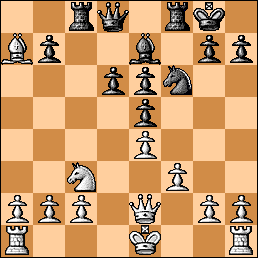
Position after 14. Bxa7??! – How to punish the greed?
Before posting the rest, I will just note that the game was drawn, with black barely holding a bad ending with R&active N vs RR.
4/3/08: As promised, here is the rest of the game.
14…Rxc3? Not a good reaction. First of all, black has 14… b6!? – a good move and ambitious. 15. Qa6 (15. Nb5 Qd7 16. a4 Ra8 17. a5 bxa5 18. Rxa5 Rfb8!! Black would need good tactics to see this move way ahead of time. Black is now slightly better. 19. O-O Rb7 20. c4 Bd8 21. Ra6 Rbxa7 22. Nxa7 Rxa7 23. Rxa7 Qxa7+ 24. Kh1 Bb6 25. b4 Bd4 26. b5 Nd7 and black is very good. Or, 15. a4 Rxc3! 16. bxc3 Qc7 17. Qe3 Qxa7 18. a5 Nd7 19. O-O d5 and again black is doing well. I did not see the shot on my 14th move. Returning to 15. Qa6, 15… Nd7 16. a4 Bh4+!? (16… Rxc3 17. bxc3 Qc7 18. Ke2 Qxc3! The strongest. Black is a little better.) 17. g3 Rxf3 18. a5 Re3+ 19. Kf2 Nc5 20. Qb5 Qg5 and now let’s show a nice sample variation: 21. Ne2 Nxe4+ 22. Kg2 Nxg3 23. hxg3 Rxg3+ 24. Kf2 Qe3+ 25. Kf1 Rf3+ 26. Kg2 Qf2 mate.
Black also has the tantalizing 14… d5?! – at the time, I thought about this move quite a bit with the idea of Rxc3 next. However, white maintains an edge if I take the n/c3 next turn and I did not understand that. There might follow 15. exd5 exd5! This simple recapture never occurred to me. It’s about equal. (I had focused on 15… Rxc3? 16. bxc3 Qa5 and this is refuted by 17. Qxe5! Qxa7 18. Qxe6+ Rf7 19. Rd1 and White is simply better here. Black has no avenues of attack.) 16. O-O-O (An important variation is 16. O-O!? b6 17. Nb5 Bc5+ 18. Kh1 e4 19. a4 Nh5 A very nice slow-motion positional move, ignoring the queenside piece formation. 20. g3 (20. a5 Nf4 21. Qd1 e3 22. Nc3 bxa5 23. Bxc5 Rxc5 24. Re1 d4 25. Ne2 Ne6 26. Qd3 Qd6 27. Kg1 Rg5 28. Qe4 Rb8 29. b3 Re5) 20… Qd7 21. f4 Qh3 with a mess.
Returning to 16. O-O-O, 16… Rxc3 17. bxc3 Qa5 18. Bf2 Qxc3 19. Kb1 Qb4+ 20. Kc1 Qa3+ 21. Kb1 Bb4?? loses, 22. Qxe5 Bc3 23. Qe6+ Kh8 24. Qb6 Cold shower! White wins. This means black should take the perpetual check draw.
There also is 14… Qa5 , a fine, solid choice. White has to play 15. Bf2 — if 15. Qe3?? Nd7! and oops! White loses the bishop on a7 and the game. I don’t even think I saw this simple possibility – it’s a nice trap.
White has another inferior choice, 15. Be3?! This is dubious, but it takes sharp vision to know why. The answer is 15… d5! and NOT 15… Rxc3?? 16. Bd2! – oops!
After 15….d5!, 16. Bd2 Qc5 17. exd5 exd5 : in this bizarre scenario, white cannot castle in either direction. If the greedy 18. Qxe5? Bd6 19. Qf5 Rce8+ 20. Kd1 (20. Kf1 Ne4! wins) 20… Qf2! and White’s position crumbles. For example, 21. Qg5 (21. Qh3 d4 22. Ne4 Nxe4 23. fxe4 Rxe4 24. Qd3 Qxg2 25. Re1 Qg4+ 26. Kc1 Rxe1+ 27. Bxe1 Bf4+ 28. Kb1 Re8 {A total rout; white must resign.}) 21…Re5 22. Qg3 Re1+ 23. Bxe1 Qd4+ 24. Kc1 Bxg3 25. Bxg3 Qc4!! A beautiful tactic. It shows how black has to open the game versus the loose, uncastled, WK in order to win.
Returning to the game,
15. bxc3 Qa5 16. Qe3! d5 17. a4 Qb5 This position is worse for black than I thought during the game.
18. Bc7?! Indicated is 18. a4 Qc4 (18… Qc6 19. O-O d4 20. Bxd4! exd4 21. cxd4! and white is much better – black’s minor pieces have no perspectives) 19. Qd3 Qc6 20. Ba5 with white edge.
18… Nd7? Correct is 18… dxe4! with full counterplay. This simple move was simply not on my radar.
19. exd5 exd5 20. a4? The grab 20. Bxe5! is correct and black cannot exploit the WK. White should win that.
20…Qc6 21. Ba5 e4 22. Bb4 Bh4+ 23. Kd1 Re8 24. Rf1 Bf6 25. a5 h6? Bad move! This game really showed a lot of inaccuracies in such a short time, on both sides.
Correct is 25… Ne5! and black is all right.: 26. Qc5 (26. fxe4 dxe4 27. Qc5 Qe6 28. Kc1 Nc4 29. Qh5 e3 30. Qe2 Rc8 {Full positional compensation.}) 26… Qe6 27. Re1 Nc4 28. Qb5 Bg5 29. Qxb7 Ne3+ 30. Kc1 exf3 31. Kb2 f2 32. Rxe3 Bxe3 33. a6 Qf7 and it is equal.
26. f4! Of course. White has control again.
26…Rc8 27. Rf2 Qc4 28. Qe2 Bxc3 29. Qxc4 Rxc4 30. Bxc3 Rxc3 31. Rb1 e3 32. Rf3 Nc5 33. Rb4 Kf7 34. f5 Kf6 Of course black should lose but in this crazy time control (G/90 + 30 sec increment), well played endings are impossible.
35. Rg4 Ra3 36. Ke2 Rxa5 37. Rxe3 Ra2 38. Rc3 Ne4 39. Rc7 Kxf5 40. Rgxg7 b5 41. Kd3 Ra1 42. Ke2 b4 43. Rgf7+ Ke5 44. Rf1 Ra2 45. Re1 Kd4 46. Kf3 Nc3 47. Rc1 Ra6 48. Rf7 Re6 49. Rf4+ Kc5 50. Ra1 d4 51. Ra5+ Kc4 52. Rff5? In time pressure, white missed 52. Ra8! Re3+ 53. Kg4 Re2 54. Rc8+ Kd5 55. Rd8+ Kc5 56. Rf5+ Kc6 57. Rxd4 Rxg2+ 58. Kh3 Rxc2 59. Rc4+ Kd7 60. Rxb4 and wins. Not an easy variation.
52… Re3+ Immediately equal was 52… b3 53. cxb3+ Kxb3 =
53. Kg4 b3 54. cxb3+ Kxb3 55. Rf2 d3 56. Ra6 Ne4 Black tricks himself with 56… h5+ 57. Kxh5 Ne4 58. Rf8 d2 59. Rd8 Re2 60. Rc6 Nc3 61. Rd3!! and wins.
57. Kf4 Re1 58. Re6?! White can dance around and eventually prevail with 58. Rf3 Nc5 59. Rc6 Kb4 60. Rf2 Nb3 61. Rb6+Kc4 62. Rd6 Kc3 63. Rd8 Nc5 64. Kg4 Re2 65. Kf3. However, he had very little time and decided to go for the easy draw.
58… Nxf2 59. Rxe1 d2 60. Rf1 Kc3 61. g4 Kd3 62. Kf3 d1=Q+ 63. Rxd1+ Nxd1 64. h4 Ne3 65. Kf4 Ng2+ 66. Kf5 Nxh4+ 67. Kf6 Nf3 68. Kg6 1/2-1/2 Almost to the proverbial last pawn.
Dealing with the Semi-Slav Harshly
In the entire Tulsa event, I had one bright spot in a game vs. Conrad Holt:
IM M. Ginsburg – C. Holt, Tulsa Qualifier 2008. Round 4. Slav Defense.
1. d4 d5 2. c4 c6 3. Nf3 Nf6 4. g3!? I like this gambit idea without the knight yet on c3. Magnus Carlsen had some nice wins with this line recently. In particular, I believe he dispatched the veteran GM Lajos Portisch rather convincingly.
4…Bf5 5. Bg2 e6 6. O-O Nbd7 7. Nc3 Bd6 8. Nh4 Bg4 9. h3 Bh5 It’s useful to put bishop a little offside. White shouldn’t go crazy, though, and expose his own king to attack.
10. Qb3 Rb8 10…Qb6 11. c5! is no fun at all for black. After 11…Qxb3 12. axb3, b3-b4-b5 happens.
11. cxd5! The right moment. Now black cannot take back with a pawn and so must take with the knight, and this concedes white a big center.

Position after 11. cxd5! – I am at least doing something right this tournament.
11…Nxd5 12. e4 Nxc3 13. bxc3 O-O 14. f4 b5 15. Nf3 Bxf3 White forced this concession. The two bishops will become very powerful when the game opens up.
16. Bxf3 c5 Black is doing his best to make counterplay. Now I hatch a very strong idea to defuse black’s principal idea of b5-b4.
17. e5 Be7 18. f5! The key idea. White must attack quickly and open the game for the bishops.
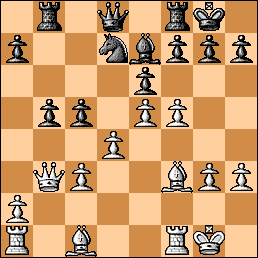
Position after 18. f5! – Hurry-up offense.
18…exf5?! I would prefer not taking although white is clearly better. The text gives up the d5 outpost.
19. Bf4! g5? Suicide and a move I did not really expect to see. Any other move defending against e6 would be better.
20. Be3 b4 21. Qc2! Black is now toast due to the threat of Qxf5 and Be4, mating. The rest of the game is a mop-up with the bishop pair showing some stylish variations near the end.
21…Qb6 22. Qxf5 Qe6 23. Qe4! The threat of Bg4 is lethal.
23…Qxh3 24. Rf2 Qh6 25. Bg4 Rbd8 Now, with a big time edge, I got confused. Can I win/mate with 26. Rh2 Qg7 27. Bf5 h6 28. Kg2 with the idea of doubling rooks on the h-file and jettisoning my c- and d-pawns? Suppose I calculate wrong? Things get kind of sharp. More perplexing, after black takes on c3 and proceeds to take on d4, I might be able to recapture on d4. But this doubling on the h-file looked so primitive! In the end, I decided just to advance my monster center pawn duo.
26. d5 (!) The simplest. 26…Rfe8 To guard against d6 winning the bishop.
27. Raf1 Bd6 28. e6! Crushing.
28…fxe6 29. Bxe6+ Kh8 30. cxb4! It’s always nice to be able to afford moves like this. White is simply playing to get on the a1-h8 diagonal.
30…Bxg3 31. bxc5 So obvious it does not merit an exclamation. 31…Bxf2+ 32. Rxf2 Nf6

Position after 32…Nf6
33. Bd4! A little embarrassing would be 33. Rxf6? Qxf6 34. Bd4 Rxe6! – a nice and unusual trick exploiting various pins – allowing black to play on after 35. Bxf6+ Rxf6 36. Qe7 Rdf8. White might win, but why bother? The text puts black in a terminal bind.
33…Rf8 34. c6 Qg7 35. Qe5 Nh5 36. c7! With utter destruction. Black resigned. If only my other Tulsa games were coherent.
1-0
More Photos!
Some Tulsa-ites (Tulsites?) (Tulsians?) (Tulipers?) (Tulsonians?) have a social conscience!

A Tulsonian Makes Her Stand
Grandmaster Goldin doesn’t know what to do order in the fast food grill joint! (inconveniently, across a frontage road from the site, but for $2 Tulsa burgers, this is the place.

What the Hell is this Strange Menu? Emu Burger? Yak Filet?
Tulsa had a strange habit of putting micro-ads into the scrub grass. These little signs only attracted the attention of vagrants, transients, and chess players staggering along the highway frontage road.
Here are some of the odd signs.

Intriguing. I will call.

Oh Yeah! Tulsa supports the Occasional Tree Amongst the Billboards!
Even More Chess!
There were many interesting games played.
Here’s a fascinating tangle from Round 4.
IM Blas Lugo – GM Jesse Kraai French Exchange
1.e4 e6 2.d4 d5 3.Nc3 Nf6 4.Bg5 dxe4!? 5.Nxe4 Be7 A favorite treatment of GM Evgeny Bareev. This is not as quiet as it appears since the kings wind up on opposite sides often. It has the advantage of avoiding many long mainline theory variations.
6.Bxf6 Bxf6 7.Nf3 Nd7 8.Qd2 O-O 9.O-O-O Be7 10.Bd3 b6 11.Kb1 The primitive 11. h4 turned out to be too slow in Suetin-Bareev, Hastings 1991, and black won after 11…Bb7 12 Kb1 Nf6. To give a counter-example, White won after 11. h4 Bb7 12. c3!? Nf6 13. Neg5 Bxf3 14. gxf3, but this position is equal after 14…Qd5. Black played 14…Kh8?! and lost in Topalov-Dreev, Linares 1995. The text move, on the other hand, also doesn’t promise much – only 3 draws in Chessbase’s BigBase. A more dangerous try is 11. Neg5!? which hopes for 11…h6? — after 11. Neg5 h6?, white scored +4 =0 -0 in ChessBase! But there’s a curiosity here: in Volokitin-P.H. Nielsen, Germany 2004, the game went 11. Neg5 h6 12. Bh7+ Kh8 13. Be4 which at first glance looks good for white. However, at first glance black missed 13…hxg5 14. Bxa8 g4! and the threat of Be7-g5 wins material for black! In the game, black played 13…Bxg5 14. Nxg5 Rb8 and lost. However, he was doing OK after 15. Nf3 Nf6 16. Bc6 Qd6 17. Ne5 Ng4! 18. Nxg4 Qc6 – he only lost due to later middlegame miscues. The truth about 13…hxg5? is revealed in another example, J. Polgar – F. Berkes, Budapest 2003, white introduced an incredible gambit: 12. Bh7+ Kh8 13. Be4 hxg5? 14. g4!! (not the greedy 14. Bxa8?) and now black faces complex problems. White stops black from playing g5-g4 and prepares to open the h-file. In the game, black lost after 14…Rb8 15. h4 g6 16. hxg5+ Kg7 17. Qf4 and white crashed through. The question is, can black live after 14. g4? Let’s take a look. First of all, 14….Ba6 15. h4! gxh4 16. g5! is crushing. For example, 16…Kg8 17. Rxh4 f5 (What else?) 18. Bc6 Rc8 19. Rdh1 Kf7 20. d5! and wins. Let’s go back to Berkes’s choice, 14…Rb8. 15. h4 and first we see that 15…gxh4? is bad: 16. g5 g6 17. Rxh4+ Kg7 18. Rdh1 Rg8 19. Rh7+ Kf8 20. Qf4! and wins.
So we go to Berkes choice, 15…g6 16. hxg5+ Kg7 17. Qf4. This is critical. We first notice that 17…Ba6 is crushed by a typical Judit Polgar brute-force tactic 18. Rh7+!! Kxh7 19. Qh2+ Kg8 20. Rh1 Bxg5+ 21. Nxg5 Qxg5+ 22. f4! and wins. We also notice that Berkes’s choice, 17…Bb7?, was crushed by the same tactic.
what about 17…Rh8!? – trying to defend on the h-file. There follows 18. Rxh8 Qxh8 (forced) 19. Ne5! and now black cannot take: 19…Nxe5? 20. Qxe5+ Kg8 21. Qxc7 Bxg5+ 22. Kb1 and the rook on b8 is trapped; white wins. And after 19…Qe8 20. Rh1! the lethal threat of 21. Nxf7! is introduced. Black still cannot take on e5 and hence is lost.
Going back to the beginning, 11. Neg5!? is best met by 11…Bxg5! and now 12. Qxg5 Qxg5+ 13. Nxg5 Nf6 is dead equal. Or, 12. Nxg5 Nf6 and black is OK and even won in B. Lopez-Kraai, San Diego 2004. That game continued 13. Qf4 Bb7 14. Rhe1 Qd6!? and here white disdained an equal ending after 15. Qxd6, opting for 15. Qh4 h6 16. Nf3 (16. Ne4! equal) Bxf3 17. gxf3 Nd5 18. Re4, eventually getting into trouble with the weak d4 pawn. White tried 13. h4!? in Sax-Dizdar, Celje 2003, and black reacted suspiciously with 13…c5?! 14. dxc5 Qd5 15. Kb1? Qxc5 equal. But white missed 15. Qf4!! Qxa2 16. Nxh7! Nxh7 17. Qe4 Nf6 18. Qxa8 Qa1+ 19. Kd2 Qxb2 20. Qxa7 and white keeps a small plus. Stronger is 13. h4 Bb7! and black is fine.
11…Bb7 12.Qf4 c5 In Sindik-Dizdar, Pula 1993, black introduced an idea similar to the game: 12…Qb8!? 13. Qg3 c5! with good play. White can improve with 13. Ne5! c5 14. Bb5! Nf6 with sharp play after 15. Nxf6+ Bxf6 16. Rhe1 and now the Korchnoi pawn grab 16…Bxg2!?
13.dxc5 Qb8! Gambits in opposite-castled king positions are effective even in the ending! This is particularly true in the “perpetual time pressure” time control of G/90+30 sec.
14.Qxb8 Raxb8 15.cxb6 Nxb6 16.b3? Correct is the solid 16. Ned2! and hunkering down. This would not create the c3 weakness in the game.
16…Na4! Very unpleasant to meet in this time control. White probably overlooked this.
17.Rde1 Bxe4 18.Bxe4 Nc3+ 19.Kb2 Bf6 This position is terrible for white.
20.Bd3 Ne4 21.Kb1 Nxf2 22.Rhf1 Nxd3 23.cxd3 Rfd8 24.Re3 a5 25.Ne5 Rd5? Correct is 25…Bxe5 26. Rxe5 a4! and black is on top. For example, 27. Kc2 axb3+ 28. axb3 Ra8 29. Kc3 Ra2 with a huge initiative.
26.Nc6 Rb7 27.Rg3 Kf8 28.Rf4! White is doing the right things now to get back in the game.
28...Be5 29.Nxe5 Rxe5 30.Rc4 f5 31.Rf3? 31. Kc1!
31…Ke7 31…Re2! is strong. 32.Rf2 Rd7 33.Kc2 Red5 34.Rf3 Kf6 35.Kc3 g5 36.d4? 36. h4! to reduce the number of pawns.
36…f4 37.a3 Kf5 Now black is gaining control again with his monstrously active king.
38.Rc5? White had to wait with 38. Rf2. The pseudo-active text is crushed.
38…g4 39.Rf1 e5! White probably underestimated this.
40.Rxd5 Rxd5 41.dxe5 Rxe5 42.Kd2 h5 43.b4 axb4 44.axb4 h4 45.Rb1 f3 46.gxf3 gxf3 47.b5 Kg4! The key move. White is lost.
48.b6 f2 49.b7 Re8 50.Rb4+ Kh3 51.Rb3 Kg2 52.b8Q Rxb8 53.Rxb8 f1Q 54.Re8 0-1











